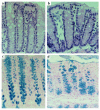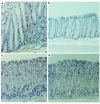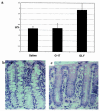Overexpression of glycine-extended gastrin in transgenic mice results in increased colonic proliferation
- PMID: 10207163
- PMCID: PMC408271
- DOI: 10.1172/JCI4910
Overexpression of glycine-extended gastrin in transgenic mice results in increased colonic proliferation
Abstract
Gastrin is a peptide hormone involved in the growth of both normal and malignant gastrointestinal tissue. Recent studies suggest that the glycine-extended biosynthetic intermediates mediate many of these trophic effects, but the in vivo relevance of glycine-extended gastrin (G-Gly) has not been tested. We have generated mice (MTI/G-GLY) that overexpress progastrin truncated at glycine-72 to evaluate the trophic effects of G-Gly in an in vivo model. MTI/G-GLY mice have elevated serum and colonic mucosal levels of G-Gly compared with wild-type mice. MTI/G-GLY mice had a 43% increase in colonic mucosal thickness and a 41% increase in the percentage of goblet cells per crypt. MTI/G-GLY mice exhibited increased colonic proliferation compared with wild-type controls, with an expansion of the proliferative zone into the upper third of the colonic crypts. Continuous infusion of G-Gly into gastrin-deficient mice for two weeks also resulted in elevated G-Gly levels, a 10% increase in colonic mucosal thickness, and an 81% increase in colonic proliferation when compared with gastrin-deficient mice that received saline alone. To our knowledge, these studies demonstrate for the first time that G-Gly's contribute to colonic mucosal proliferation in vivo.
Figures





Similar articles
-
Signaling pathways associated with colonic mucosa hyperproliferation in mice overexpressing gastrin precursors.Cancer Res. 2005 Apr 1;65(7):2770-7. doi: 10.1158/0008-5472.CAN-04-0978. Cancer Res. 2005. PMID: 15805277
-
Inactivating cholecystokinin-2 receptor inhibits progastrin-dependent colonic crypt fission, proliferation, and colorectal cancer in mice.J Clin Invest. 2009 Sep;119(9):2691-701. doi: 10.1172/JCI38918. Epub 2009 Aug 3. J Clin Invest. 2009. PMID: 19652364 Free PMC article.
-
Processing and proliferative effects of human progastrin in transgenic mice.J Clin Invest. 1996 Oct 15;98(8):1918-29. doi: 10.1172/JCI118993. J Clin Invest. 1996. PMID: 8878444 Free PMC article.
-
Lessons from genetically engineered animal models. I. Physiological studies with gastrin in transgenic mice.Am J Physiol. 1999 Jul;277(1):G6-11. doi: 10.1152/ajpgi.1999.277.1.G6. Am J Physiol. 1999. PMID: 10409145 Review.
-
Gastrin as a growth factor in the gastrointestinal tract.Regul Pept. 2000 Sep 25;93(1-3):37-44. doi: 10.1016/s0167-0115(00)00176-2. Regul Pept. 2000. PMID: 11033051 Review.
Cited by
-
Progress in Research on Colorectal Cancer-Related Microorganisms and Metabolites.Cancer Manag Res. 2020 Sep 21;12:8703-8720. doi: 10.2147/CMAR.S268943. eCollection 2020. Cancer Manag Res. 2020. PMID: 33061569 Free PMC article. Review.
-
Expression of cholecystokinin-2/gastrin receptor in the murine pancreas modulates cell adhesion and cell differentiation in vivo.Am J Pathol. 2004 Dec;165(6):2135-45. doi: 10.1016/S0002-9440(10)63263-4. Am J Pathol. 2004. PMID: 15579455 Free PMC article.
-
A gastrin precursor, gastrin-gly, upregulates VEGF expression in colonic epithelial cells through an HIF-1-independent mechanism.Int J Cancer. 2010 Jun 15;126(12):2847-57. doi: 10.1002/ijc.25001. Int J Cancer. 2010. PMID: 19876923 Free PMC article.
-
Effects of gastrin 17 on beta-catenin/Tcf-4 pathway in Colo320WT colon cancer cells.World J Gastroenterol. 2006 Dec 14;12(46):7482-7. doi: 10.3748/wjg.v12.i46.7482. World J Gastroenterol. 2006. PMID: 17167838 Free PMC article.
-
Stimulation of proliferation in the colorectal mucosa by gastrin precursors is blocked by desferrioxamine.Am J Physiol Gastrointest Liver Physiol. 2010 Jul;299(1):G220-7. doi: 10.1152/ajpgi.00046.2010. Epub 2010 Apr 15. Am J Physiol Gastrointest Liver Physiol. 2010. PMID: 20395538 Free PMC article.
References
-
- Walsh, J.H. 1994. Gastrin. In Gut peptides. J.H. Walsh and G.J. Dockray, editors. Raven Press. New York, NY. 75–121.
-
- Johnson LR. New aspects of the trophic action of gastrointestinal hormones. Gastroenterology. 1977;72:788–792. - PubMed
-
- Willems G, Vansteenkiste Y, Limbosch JM. Stimulating effect of gastrin on cell proliferation kinetics in canine fundic mucosa. Gastroenterology. 1972;62:583–589. - PubMed
-
- Crean GP, Marshall MW, Rumsey RDE. Parietal cell hyperplasia induced by the administration of pentagastrin to rats. Gastroenterology. 1969;57:147–155. - PubMed
Publication types
MeSH terms
Substances
Grants and funding
LinkOut - more resources
Full Text Sources
Molecular Biology Databases

